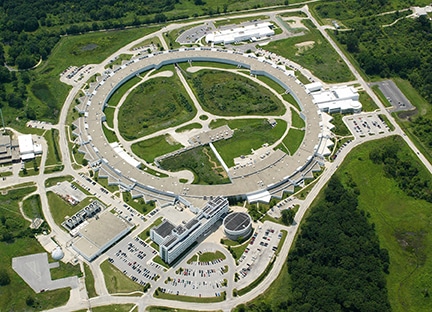Jul 31 2019
The U.S. Department of Energy’s Argonne National Laboratory has obtained approval from the Office of Science (SC) for the next phase of the $815M upgrade of the Advanced Photon Source (APS), a principal national research facility that empowers researchers to perform discoveries impacting national security, economy, and technologies.
 The Advanced Photon Source. (Image credit: Argonne National Laboratory)
The Advanced Photon Source. (Image credit: Argonne National Laboratory)
The Critical Decision 3 (CD-3) milestone approval from DOE is an important recognition of DOE’s consent to Argonne’s final design report for the complicated APS Upgrade (APS-U). The approval permits the laboratory to go forward with procurements required to construct the nation’s brightest energy, storage-ring based X-ray source.
Through this upgrade, the APS is positioned to be a world leader among the new generation of storage-ring light sources currently emerging.
Argonne’s APS, which functions similar to a massive X-ray microscope, is a DOE Office of Science User Facility supported by the Scientific User Facilities Division of the Basic Energy Sciences Program in the Office of Science.
It generates exceptionally bright, focused X-rays peering through dense materials and illuminating the chemistry and structure of matter at the atomic and molecular level. For comparison, the X-rays synthesized at the existing APS are nearly one billion times brighter than the X-rays synthesized in a regular dentist office.
Once the upgrade is completed, the APS-U will empower researchers with a much more robust tool for extending their studies into new domains, speeding up effective discoveries in science and technology and urging U.S. security and prosperity.
“This project will be a scientific game-changer,” stated Robert Hettel, director of the APS Upgrade project.
The APS Upgrade will allow researchers to see things at a scale they have never seen before with storage-ring X-rays. We’ll be able to look deep inside real samples, such as biological organisms, and observe atoms moving in real time. Such extreme levels of detail will open new frontiers and discoveries in basic science and help solve pressing problems across a wide range of industries.
Robert Hettel, Director, APS Upgrade Project
Following are the examples of possible future pivotal discoveries at the upgraded APS:
- Revolutionary systems for transforming sunlight into energy and means to store that energy
- Better insights into the way information is processed and stored by the brain with neurons
- New drugs for the treatment of infections resistant to existing antibiotics
- Detailed mechanisms using which pollutants propagate through soil
- More efficient, cleaner biofuels.
- Transformational insight into the structure of the inner core of the Earth
Through this upgrade, the brightness of the already super-bright X-rays will be increased by another 100 to 1,000 times over the existing facility and, based on the method employed, will enable researchers to map the identity, dynamics, and position of the key atoms in a sample.
Each year, over 5,500 scientists from every U.S. state, Washington D.C., Puerto Rico, and countries across the globe perform experiments at the APS that have:
- Supported the advent of a number of pharmaceuticals (including one of the most successful drugs to stop the progression of the HIV virus)
- Resulted in two Nobel Prizes (and contributed to a third)
- Enhanced products including better, renewable batteries, stronger infrastructure materials, more efficient vehicles, and more robust electronics
- Enhanced processes for oil extraction from shale
Researchers from the APS have also unraveled secrets of archeology and history by analyzing the composition of an ancient Egyptian mummy and the arms of SUE, the Tyrannosaurus rex specimen at The Field Museum of Chicago. Moreover, APS research has enhanced the understanding of the solar system and the Earth itself by means of studies of space dust, geological rocks and minerals, and meteorites.
The upgraded APS will enable science at a completely new scale, enabling discoveries across a wide range of research from microelectronics to polymers to quantum.
Paul Kearns, Director, Argonne National Laboratory
Kearns continued, “It’s an exciting time as Argonne is building two powerful facilities for the world’s scientific community. Together, the upgraded APS and our Aurora exascale computing system will provide powerful new capabilities to accelerate science and technology for U.S. prosperity and security.”
X-rays at the APS are synthesized by electrons accelerated to high energies. These electrons propagate at almost the speed of light as they pass via arrays of magnets in a 1.1-km circular storage ring.
X-rays emitted from the storage ring pass into beamlines fitted with experimental end stations. At the beamlines, scientists use different instrumentation to analyze the chemistry and structure of matter in an extensive range of systems over a wide spectrum of time and energy scales.
The aim of the project is to substitute the APS storage ring and update or create X-ray beamlines and other equipment to build the more robust X-ray facility. The APS-U storage ring will have a multi-bend achromat lattice and a new design, with considerably more magnet-focusing cells and bending magnets when compared to the existing machine, leading to the production of brighter X-rays.
Replacement of the old storage ring with the new one is slated to commence in June 2022. The installation and following ring commissioning duration will last for nearly a year. After that, the APS-U X-ray beamlines will be brought online for scientists.
We thank the Department of Energy for their confidence in our team’s design and their authorization to complete this important project. This ambitious effort will ensure that the United States remains at the forefront of hard X-ray sciences for decades to come.
Stephen Streiffer, Director, APS, Argonne National Laboratory
Streiffer is also the Associate Laboratory Director for Photon Sciences at Argonne.